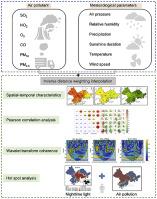Atmospheric Environment ( IF 4.2 ) Pub Date : 2021-04-14 , DOI: 10.1016/j.atmosenv.2021.118415 Mengmeng Hu , Yafei Wang , Shuang Wang , Mengyu Jiao , Guohe Huang , Beicheng Xia

|
Analyzing the distribution of air pollution and its influencing factors is critical for regional air pollution prevention and control. This study takes the Pearl River Delta (PRD) as a study area, analyzes the spatial-temporal changes in air pollution (including sulfur dioxide (SO2), nitrogen dioxide (NO2), ozone (O3), carbon monoxide (CO), and particles with an aerodynamic diameter less than 10 μm (PM10) and less than 2.5 μm (PM2.5)) from 2006 to 2019, and explores the relationship between air pollution and meteorological factors. The results showed that (1) most air pollutant concentrations decreased from 2006 to 2019, with the most obvious change being the decrease in the SO2 concentration from 52.4 μg/m3 to 7.8 μg/m3. The O3 concentration increased, with a Sen's slope of 0.649 μg m−3·year−1. Air pollution was lower in coastal areas (Shenzhen and Huizhou) than in inland areas (Foshan and Zhaoqing), affected by ocean atmospheric transmission, and coastal areas had the cleanest air quality. (2) Air pollutants had high correlations with air pressure, relative humidity, precipitation, and temperature. The most serious air pollution was found in winter, which was partially due to the meteorological conditions in winter that were more unfavorable for pollutant dispersion and dilution than were the conditions in other seasons. (3) Through the wavelet coherence method, an interesting finding revealed that other air pollution and meteorological factors exhibited complex period-dependent characteristics that were significantly related to PM2.5. Areas with less air pollution were more susceptible to meteorological factors. (4) The overlapping area of the PM2.5 distribution hotspot and nighttime light hotspot was mainly in Foshan and Guangzhou, representing approximately 12.1% of the study area. Our work contributes to the literature by considering seasonal and timescale-dependent characteristics of meteorological factors affecting air pollutant emissions, and it provides new insights into recognizing regions that need to prioritize urban air pollution control based on hotspot analysis.
中文翻译:

珠江三角洲空气污染的时空异质性及其与气象因子的关系
分析空气污染的分布及其影响因素对于区域空气污染的预防和控制至关重要。本研究以珠江三角洲(PRD)为研究区域,分析了空气污染(包括二氧化硫(SO 2),二氧化氮(NO 2),臭氧(O 3),一氧化碳(CO)的时空变化。),以及从2006年至2019年的空气动力学直径小于10μm(PM 10)和小于2.5μm(PM 2.5)的颗粒,并探讨了空气污染与气象因素之间的关系。结果表明:(1)从2006年到2019年,大多数空气污染物浓度下降,最明显的变化是SO 2的下降浓度从52.4μg/ m 3到7.8μg/ m 3。O 3浓度增加,Sen斜率为0.649μgm -3 ·年-1。受海洋大气传输的影响,沿海地区(深圳和惠州)的空气污染低于内陆地区(佛山和肇庆),沿海地区的空气质量最干净。(2)空气污染物与气压,相对湿度,降水和温度具有高度相关性。冬季发现的空气污染最严重,部分原因是冬季的气象条件比其他季节的条件更不利于污染物的扩散和稀释。(3)通过小波相干法,一个有趣的发现表明,其他空气污染和气象因素还表现出复杂的周期相关特征,与PM 2.5显着相关。。空气污染少的地区更容易受到气象因素的影响。(4)PM 2.5分布热点和夜间光热点的重叠区域主要在佛山和广州,约占研究区域的12.1%。我们的工作通过考虑影响空气污染物排放的气象因素的季节和时间尺度相关特征,为文献做出了贡献,并且为基于热点分析识别需要优先控制城市空气污染的地区提供了新见识。











































 京公网安备 11010802027423号
京公网安备 11010802027423号